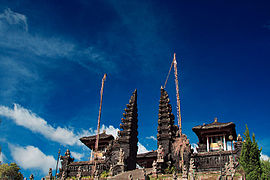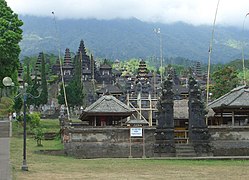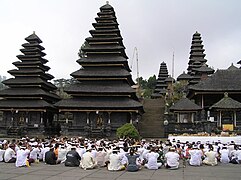Besakih Temple
| Pura Besakih | |
|---|---|
 Pura Besakih, the holiest of all Balinese Hindu temples. | |
| General information | |
| Type | Pura |
| Architectural style | Balinese |
| Location | Besakih, Karangasem, Bali, Indonesia |
| Address | Besakih, Rendang, Karangasem Regency, Bali 80863 |
| Coordinates | 8°22′28″S 115°27′03″E / 8.374368°S 115.450936°E |
| Estimated completion | 15th-century |
| Website | |
| www | |
Besakih Temple (Balinese: ᬧᬸᬭᬩᭂᬲᬓᬶᬄ) is a pura (Hindu temple complex) in the village of Besakih on the slopes of Mount Agung in eastern Bali, Indonesia. It is the most important, largest, and holiest temple of Balinese Hinduism,[1] and one of a series of Balinese temples. Perched nearly 1000 meters up the side of Gunung Agung, it is an extensive complex of 23 separate but related temples with the largest and most important being Pura Penataran Agung. The temple is built on six levels, terraced up the slope. The entrance is marked by a candi bentar (split gateway), and beyond it, the Kori Agung is the gateway to the second courtyard.[2]
History
The precise origins of the temple are unclear but its importance as a holy site almost certainly dates from prehistoric times. The stone bases of Pura Penataran Agung and several other temples resemble megalithic stepped pyramids, which date back at least 2,000 years.
It was certainly used as a Hindu place of worship from 1284 when the first Javanese conquerors settled in Bali. By the 15th century, Besakih had become a state temple of the powerful Gelgel dynasty.[2]
Location
The temple is on the slopes of Mount Agung, the principal volcano of Bali.[3]
Architecture

Pura Besakih is a complex made up of twenty-three temples that sit on parallel ridges. It has stepped terraces and flights of stairs that ascend to several courtyards and brick gateways that lead up to the main spire or Meru structure, which is called Pura Penataran Agung. All this is aligned along a single axis and designed to lead the spiritual person upward and closer to the mountain which is considered sacred.[4]
The main sanctuary of the complex is the Pura Penataran Agung. The symbolic center of the main sanctuary is the lotus throne, or padmasana, which is therefore the ritual focus of the entire complex. It dates to around the seventeenth century.[5]
A series of eruptions of Mount Agung in 1963, which killed approximately 1,700 people[6][7] also threatened Pura Besakih. The lava flows missed the temple complex by mere meters. The Balinese people regarded the saving of the temple as miraculous, and a signal from the gods that they wished to demonstrate their power but not destroy the monument the Balinese faithful had erected.
Festivals
Each year there are at least seventy festivals held at the complex since almost every shrine celebrates a yearly anniversary. This cycle is based on the 210-day Balinese Pawukon calendar year.[5]
It had been nominated as a World Heritage Site as early as 1995 but was pulled out in 2015.
Visitors
In 2013, foreign visitors accounted for 84,368 persons (77.2 percent of all visitors), while domestic visitors accounted for 24,853 persons (22.8 percent).[8]
Maintenance efforts

On 13 March 2023 President of Indonesia Joko Widodo inaugurated the arrangement of facilities for the sacred area of Pura Agung Besakih in Karangasem Regency, Bali Province. In his speech, President Jokowi emphasized the importance of caring for Pura Agung Besakih which is very sacred to Hindus, not only Hindus in Bali, but throughout the archipelago. "We must protect this holy temple, we must maintain it with full respect so that Hindus and visitors who come to Pura Agung Besakih can feel its aura of holiness, because by maintaining its purity, it maintains cleanliness, it maintains tidiness and at the same time it becomes a beautiful place," said the President. Jokowi. Apart from that, Pura Agung Besakih is always packed with visitors, especially if there is a big ceremony, especially the Bhatara Turun Kabeh Ceremony which is held every sasih kadasa. The President believes that the arrival of more and more people and visitors without being balanced with arrangements and anticipation for the future will cause chaos and discomfort.[9]
Gallery
-
The main temple of Besakih
-
Meru towers of Pura Besakih
-
Pura Besakih
-
Pura Besakih
-
A puja ceremony at the Besakih Temple
-
A prayer ceremony at Besakih Temple
-
Bali view from Besakih/Mother Temple's main gate
See also
Notes
- ^ "Mount Agung and Pura Besakih". Sacred Destinations. Retrieved 20 July 2010.
- ^ a b Lonely Planet: Bali and Lombok, April 2009, p 215
- ^ "Mount Agung | Indonesia, Map, & Facts | Britannica". www.britannica.com. Retrieved 30 November 2023.
- ^ Michell, George (1998). The Hindu temple: an introduction to its meaning and forms. University of Chicago Press. p. 168. ISBN 0-226-53230-5.
- ^ a b Davison, Julian (2003). Introduction to Balinese architecture. Tuttle Publishing. p. 60. ISBN 0-7946-0071-9.
- ^ "Geology of Mt.Agung". Pusat Vulkanologi & Mitigasi Bencana Geologi — VSI. Archived from the original on 29 September 2008. Retrieved 26 April 2009.
- ^ Zen, M. T.; Hadikusumo, Djajadi (December 1964). "Preliminary report on the 1963 eruption of Mt.Agung in Bali (Indonesia)". Bulletin Volcanologique. 27 (1). The SAO/NASA Astrophysics Data System: 269–299. Bibcode:1964BVol...27..269Z. doi:10.1007/BF02597526.
- ^ "Karangasem Perlu Ciptakan Objek Wisata Baru". 15 June 2014. Archived from the original on 29 August 2014. Retrieved 15 June 2014.
- ^ "President Jokowi inaugurated the arrangement of facilities at the Besakih Agung Temple". Ministry of State Secretariat, Republic of Indonesia.
Further reading
- I Nyoman Darma Putra and Michael Hitchcock (2005) Pura Besakih: A world heritage site contested in Indonesia and the Malay World, Volume 33, Issue 96 July 2005, pages 225 - 238
- Stuart-Fox, David J.(2002) Pura Besakih: temple, religion and society in Bali KITLV, Original from the University of Michigan (Digitized 5 September 2008 into Google Books) ISBN 90-6718-146-3, ISBN 978-90-6718-146-4 . 470 pages
External links
 Besakih travel guide from Wikivoyage
Besakih travel guide from Wikivoyage









